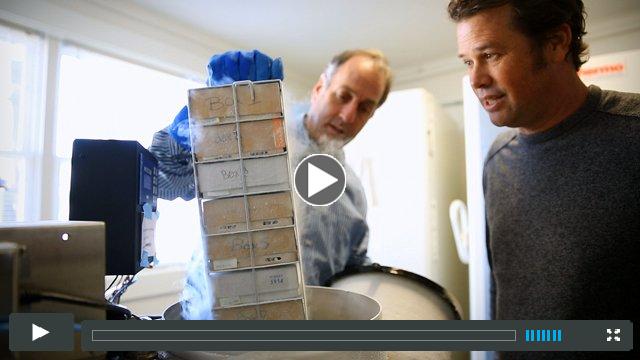Ocean Genome Legacy Newsletter
March 2014
|
|
OGL Newsletter
|  |
|
|
|
As part of our newsletter series highlighting interesting marine research in our new home at Northeastern University's Marine Science Center, this month we focus on the exploding field of bioinformatics with application to coral disease and conservation.
And, as always, follow our expeditions and other news from the marine world on our Facebook and Twitter pages!
|
Bioinformatics at the Marine Science Center
|

|
Vast server rooms, like the one pictured above, are used by students and faculty in Northeastern University's Master's degree program in Bioinformatics and Computational Biology for research and training in biology, computer science, and IT.
|
Always intrigued by living things, Northeastern University faculty member Steve Vollmer, PhD, turned an early interest in veterinary medicine to a passion for marine research. In particular, Vollmer is fascinated by evolutionary biology, i.e., how species and populations change over time. Along the way he realized the vital importance of the new field of bioinformatics-- the study of molecular sequence information-- and made it an integral part of his research. Now, Vollmer heads the bioinformatics program at Northeastern and runs an active research lab in marine evolutionary ecology with a primary focus on reef corals.
DNA: The Information Molecule
The word bioinformatics may sound intimidating at first, even to seasoned biologists! In simplest terms, bioinformatics is the study of the sequence of molecules that, like DNA and protein, are made up of long chains of smaller molecules (called subunits) attached end to end, like beads on a string. The order of the different subunits can contain information or meaning, just like the order of the letters on a page that make up words and sentences.
 | |
DNA, often called the information molecule, is a string of nucleotides named A, C, G, and T.
|
There are many types of these so-called biopolymers, the most well known being DNA. Each type of biopolymer is functionally distinct, defined by the set of subunits used to put it together. For example, all DNA molecules are formed by joining the same set of four subunits together in different combinations.
Fundamentally, differences between any two organisms, whether they are members of the same species or not, come down to differences in the sequences of their DNA. As organisms evolve, their evolution is reflected in, and recorded by, the changes in these DNA sequences. For this reason, scientists can use comparisons between DNA sequences, a task done quickest by computers, to explore the biodiversity of ecosystems and the evolutionary histories of the organisms they contain.
Coral Genomics
Using a bioinformatics approach, the Vollmer Lab explores the genetic (DNA) differences that make some Staghorn corals resistant to White Band Disease (WBD) while others succumb. WBD is important; it has nearly wiped out this species of coral across the entire Caribbean, prompting the U.S. Fish and Wildlife Service to list it as a protected species under the Endangered Species Act. Only about 6% of Staghorn corals are resistant to WBD. Comparing resistant and non-resistant colonies can highlight which genes are important in a successful immune response to this devastating disease, knowledge that can be used in conservation efforts.
 | |
This Acropora coral colony has been affected by White Band Disease.
|
The Vollmer lab also investigates the varying reproductive strategies of Pocillopora corals, and the forces driving the possible divergence of the periwinkle species Littorina saxatilis into separate species. Research in the Vollmer lab shows clearly how great discoveries may be achieved using bioinformatics!
Bioinformatics and OGL
One of the main functions of OGL is to support this kind of bioinformatics research, by helping make DNA samples from many organisms available to researchers all over the world.
Vollmer's work is just one example of how biorepositories can serve a crucial role for research. As DNA sequencers and computers get more powerful, scientists will no longer be limited by the rate at which they can generate sequence information, but instead by their ability to find the biological specimens they need. That's where OGL steps in. By helping scientists to collect and share DNA from thousands of species from all throughout the sea, OGL hopes to fuel the revolution in bioinformatics. Watch a video, below, about OGL and Dr. Vollmer's research.
 | |
Largest marine biorepository finds home at Northeastern
|
|
Video: OGL and Northeastern University's Marine Science Center
|
Last week, OGL and Northeastern University hosted an event celebrating our new partnership. Watch the video, debuted at the start, detailing how the university and biorepository will work together on scientific issues of importance in the seas.
|
Coming Soon... More MSC Research Highlights
|
We'll highlight more of the exciting research going on at Northeastern's Marine Science Center and focus on the ways OGL can contribute to its new community.
|
|
DONATE TO OGL
|
| |
Want to help OGL document and preserve the spectacular genetic diversity of our world's oceans? Visit
www.northeastern.edu/marinescience/support-the-msc/
and specify "OGL" in your gift.
Thanks for your continued support!
|
|
|
|
If you've enjoyed reading this newsletter and would like to subscribe, click
up above on "Join Our Mailing List," then enter your email address in the window that appears.
To learn more about OGL and its mission, just click "More About Us" in the Quick Link box. Thanks for your interest!
Sincerely,
Dan Distel, Ph.D.
Ocean Genome Legacy   |
|
|
|
|
|